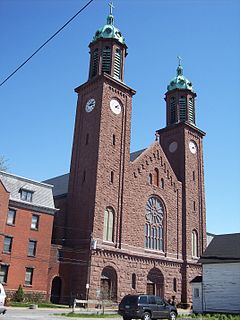 W
WThe Onondaga Limestone is a group of hard limestones and dolomites of Devonian age that form an important geographic feature in some areas in which it outcrops; in others, especially its Southern Ontario portion, the formation can be less prominent as a local surface feature.
 W
WThe Corpus Christi R.C. Church Complex is a series of several buildings located on Buffalo's historic East Side within the Roman Catholic Diocese of Buffalo. The complex contains the Kolbe Center, Sears Street Hall, Rectory, Convent and the huge sandstone church that towers over the neighborhood. The complex school was closed in 1982 and has been razed.
 W
WThe Genesee County Courthouse is located at the intersection of Main and Ellicott streets in Batavia, New York, United States. It is a three-story Greek Revival limestone structure built in the 1840s.
 W
WThe Gridley Building, built in 1867 and known previously as the Onondaga County Savings Bank Building, is a prominent historic building on Clinton Square and Hanover Square in Syracuse, New York, United States. It was designed by Horatio Nelson White and was built adjacent to what was then the Erie Canal and is now Erie Boulevard.
 W
WThe Hall of Languages is a Syracuse University building designed by Horatio Nelson White in the Second Empire architectural style, and built in 1871–73. It was the first building constructed on the Syracuse University campus and the building originally housed the entire university.
 W
WLe Roy, or more commonly LeRoy, is a town in Genesee County, New York, United States. The population was 7,641 at the 2010 census. The town is named after one of the original land owners, Herman Le Roy. The town lies on the eastern edge of Genesee County. Within the town is a village also named Le Roy. The town was home to Pearle Bixby Waite, known by many for inventing what we know today as JELL-O.
 W
WThe White Memorial Building is a Gothic-style building prominently located on the main downtown street of Syracuse, New York. It was designed by Joseph Lyman Silsbee.